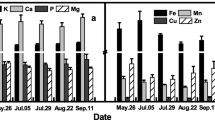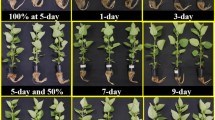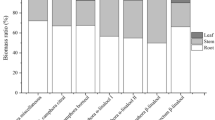Abstract
Astragalus membranaceus is an important traditional Chinese herb whose roots have been used for medicinal purposes for more than 2000 years. Because of excessive exploitation, the wild resources are currently almost exhausted, and therefore, artificial planting of Astragalus membranaceus has been increasingly important. But to date, few studies have focused on the active ingredients and mineral element of Astragalus membranaceus in the Qinghai-Tibet Plateau.
In this study, five density gradients (M1: 10 cm × 25 cm, M2: 15 cm × 25 cm, M3: 20 cm × 25 cm, M4: 25 cm × 25 cm and M5: 30 cm × 25 cm) were assessed to evaluate the effects of various planting densities on the mineral element and secondary metabolite content of Astragalus membranaceus roots in different months. It was found that the content of calycosin-7-O-β-D-glucoside and astragaloside IV reached its highest in October. Ononin content increased month by month, while formononetin content decreased during months. Calycosin content did not show significant changes during seasons. Taken together, these results suggest that the optimal planting density is 15 cm × 25 cm (D2) and the optimal harvest period is October. According to the results, the Cu content in all samples did not exceed the limit (20 mg/kg). Principal component analysis (PCA) revealed that Na, P, K Al, Ba, Ca, Fe, Li, and Mn were selected as characteristic elements of Astragalus membranaceus. The results also showed a high correlation between elements and active ingredients. Ba and Co had extremely significant associations with astragaloside IV.



Similar content being viewed by others
Data Availability
Raw data are available upon request.
References
Abla M, Sun H, Li Z, Wei C, Gao F, Zhou Y, Feng J (2019) Identification of miRNAs and Their Response to Cold Stress in Astragalus Membranaceus. Biomolecules 9(5):182
Pistelli LF (2002) Secondary metabolites of genus Astragalus: structure and biological activity. In: Rahman A (ed) Studies in natural product chemistry. Volume 27: Bioactive natural products, Part H. Elsevier Science Publishers, Amsterdam, pp 443–545
Ko JK-S, Lam FY-L, Cheung AP-L (2005) Amelioration of experimental colitis by Astragalus membranaceus through anti-oxidation and inhibition of adhesion molecule synthesis. World J Gastroenterol 11:5787–5794
Chang TS, Wang TY, Yang SY, Kao, YH, Wu JY, Chiang CM (2019) Potential industrial production of a well-soluble, alkaline-stable, and anti-inflammatory isoflavone glucoside from 8-hydroxydaidzein glucosylated by recombinant amylosucrase of deinococcus geothermalis. Molecules 24(12):2236
Agyemang K, Han L, Liu E, Zhang Y, Wang T, Gao X (2013) Recent advances in astragalus membranaceus anti-diabetic research: pharmacological effects of its phytochemical constituents. Evid Based Complement Alternat Med 2013:654643
Du X, Zhao B, Li J, Cao X, Diao M, Feng H, Chen X, Chen Z, Zeng X (2012) Astragalus polysaccharides enhance immune responses of HBV DNA vaccination via promoting the dendritic cell maturation and suppressing Treg frequency in mice. Int Immunopharmacol 14:463–470
Yin X, Zhang Y, Wu H, Zhu X, Zheng X, Jiang S, Zhuo H, Shen J, Li L, Qiu J (2019) Protective effects of astragalus saponin I on early stage of diabetic nephropathy in rats. J Pharmacol Sci 95(2):256–266
Zhang WD, Zhang C, Wang XH, Gao PJ, Zhu DL, Chen H, Liu RH, Li HL (2006) Astragaloside IV dilates aortic vessels from normal and spontaneously hypertensive rats through endothelium-dependent and endothelium-independent ways. Planta Med 72:621–626
Xue HX, Gan F, Zhang ZQ, Hu JF, Chen XX, Huang KH (2015) Astragalus polysaccharides inhibits PCV2 replication by inhibiting oxidative stress and blocking NF-κB pathway. Int J Biol Macromol 81:256–266
Yang B, Xiao B, Sun T (2013) Antitumor and immunomodulatory activity of Astragalus membranaceus polysaccharides in H22 tumor-bearing mice. Int J Biol Macromol 62:287–290
National Pharmacopoeia Committee (2015) Pharmacopoeia of People’s Republic of China [M]. Chemical Industry Press, Beijing
European Directorate for the Quality of Medicines and Healthcare (2017) European Pharmacopoeia 9.0. Council of Europe; Strasbourg, France
Cheng M, Chi XL, Wang H, Yang G (2019) Astragalus analysis on the present situation and issues in international trade. Mod Chin Med 21:424–428
Gai QY, Jiao J, Wang X, Liu J, Wang ZY, Fu YJ (2019) Chitosan promoting formononetin and calycosin accumulation in Astragalus membranaceus hairy root cultures via mitogen-activated protein kinase signaling cascades. Sci Rep 9:10367
Zhang LJ, Liu HK, Hsiao PC, Kuo LM, Lee IJ, Wu TS, Chiou WF, Kuo YH (2011) New isoflavonoid glycosides and related constituents from astragali radix ( Astragalus membranaceus ) and their inhibitory activity on nitric oxide production. J Agric Food Chem 59:1131–1137
Ma JY, Zhang H, Ling GL (2011) The resources on wild Astragalus Membranaceus in the Great Khingan Mountain. Territ Nat Res Study 06:72–73
Qin XL (2013) Root ratio in wheat breeding process and evolution of allometric relationships. J Lanzhou Univ 23-36
Jia Q, Sun L, Ali S, Liu D, Zhang Y, Ren X, Zhang P, Jia Z (2017) Deficit irrigation and planting patterns strategies to improve maize yield and water productivity at different plant densities in semi-arid regions. Sci Rep 7:13881
Khan A, Najeeb U, Wang L, Tan DKY, Yang G, Munsif F, Ali S, Hafeez A (2017) Planting density and sowing date strongly influence growth and lint yield of cotton crops. Field Crop Res 209:129–135
Wu L, Deng Z, Cao L, Meng L (2020) Effect of plant density on yield and quality of perilla sprouts. Sci Rep 10:9937
Xiong F, Nie X, Zhao X, Yang L, Zhou G (2018) Effect of plant density and harvest stage on yield and quality of rheum tanguticum. Int J Agric Biol 20(11):2408–2416
Zheng Y, Zhang Y, Wu J (2016) Yield and quality of Moringa oleifera under different planting densities and cutting heights in southwest China. Ind Crop Prod 91:88–96
Li SN (2015) Effects of planting density and sowing-date on growth and secondary metabolites accumulation of Astragalus mongholicus. Northwest A&F Univ:11–18
Ma SZ, Chen ZG, Zhang DX, Ma JM (2004) Longxi experimental study on Astragalus Membranaceus of different density cultivation. J Anhui Agric Sci 01:118–119
Tokalioglu S (2012) Determination of trace elements in commonly consumed medicinal herbs by ICP-MS and multivariate analysis. Food Chem 134:2504–2508
Chen JD, Hong S, Noriyuki K, Wang P, Chen J, Hong XY, Feng MJ, Fang-Jie Z (2020) Overexpression of the manganese/cadmium transporter OsNRAMP5 reduces cadmium accumulation in rice grain. J Exp Bot 71(18):5705–5715
Rehecho S, Hidalgo O, García-Iñiguez de Cirano M, Navarro I, Astiasarán I, Ansorena D, Cavero RY, Calvo MI (2011) Chemical composition, mineral content and antioxidant activity of Verbena officinalis L. LWT Food Sci Technol 44:875–882
Howie HL, Hay AM, de Wolski K, Waterman H, Lebedev J, Fu X, Culp-Hill R, D’Alessandro A, Gorham JD, Ranson MS, Roback JD, Thomson PC, Zimring JC (2019) Differences in Steap3 expression are a mechanism of genetic variation of RBC storage and oxidative damage in mice. Blood Adv 3:2272–2285
Sun JB, Gao YG, Zang P, Yang H, Zhang LX (2013) Mineral elements in root of wild Saposhnikovia divaricata and its rhizosphere soil. Biol Trace Elem Res 153:363–370
Subramanian R, Gayathri S, Rathnavel C, Raj V (2012) Analysis of mineral and heavy metals in some medicinal plants collected from local market. Asian Pac J Trop Biomed 2:S74–S78
Zongtai L, Dexi L, Lijie Z, Linghao L (2020) Mineral elements and active ingredients in root of wild Paeonia lactiflora growing at Duolun County, Inner Mongolia. Biol Trace Elem Res 193:548–554
Shen N, Cui Y, Xu W, Zhao X, Yang L (2017) Impact of phosphorus and potassium fertilizers on growth and anthraquinone content in Rheum tanguticum Maxim. ex Balf. Ind Crop Prod 107:312–319
Wang LL, Yang LC, Xiong F, Nie XQ, Li CB, Xiao YM, Zhou GY (2020) Nitrogen fertilizer levels affect the growth and quality parameters of Astragalus mongolica. Molecules 25(2):381
Song QY (2017) Combined Application of nitrogen, phosphorus and potassium on Yield and Quality of Radix Astragali. Beijing University Traditional Chinese Medicine, Beijing, pp 21–26
Zhang S, Liao X, Zhang C, Xu H (2012) Influences of plant density on the seed yield and oil content of winter oilseed rape (Brassica napus L.). Ind Crop Prod 40:27–32
Xin B (2015) Factors of climate, soil and studies on the growth effect of age on quality of Radix Astragali. Beijing University Traditional Chinese Medicine, Beijing, pp 13–13
Qiang ZZ, Wang Y, Xiao W, Wang MW, Li S, Li CY (2016) A sequence of hedysarum appropriate feature analysis of inorganic elements in different organs of the growing season. J Chin Med Mater 39:53–58
Zhang W, Ouyang Z, Zhao M, Wei Y, Peng H, Wang Q, Guo L (2015) The influences of inorganic elements in soil on the development of famous - region Atractylodes lancea (Thunb.) DC. Pharmacogn Mag 11:337–344
Ben Mrid R, Bouchmaa N, Bouargalne Y, Ramdan B, Karrouchi K, Kabach I, El Karbane M, Idir A, Zyad A, Nhiri M (2019) Phytochemical characterization, antioxidant and in vitro cytotoxic activity evaluation of Juniperus oxycedrus Subsp. oxycedrus needles and berries. Molecules 24(3):502
Noda Y, Furukawa J, Aohara T, Nihei N, Hirose A, Tanoi K, Nakanishi TM, Satoh S (2016) Short day length-induced decrease of cesium uptake without altering potassium uptake manner in poplar. Sci Rep 6:38360
WHO/FAO/IAEA (1996) Trace elements in human nutrition and health. World Health Organization, Switzerland
Gostner JM, Wrulich OA, Jenny M, Fuchs D, Ueberall F (2012) An update on the strategies in multicomponent activity monitoring within the phytopharmaceutical field. BMC Complement Altern Med 12:18
Zhang J, Yang R, Chen R, Li YC, Peng Y, Liu C (2018) Multielemental analysis associated with chemometric techniques for geographical origin discrimination of tea leaves (Camelia sinensis) in Guizhou Province, SW China. Molecules 23(11):3013
Li L, Zheng S, Yang Q, Chen S, Huang L (2016) Distinguishing Astragalus mongholicus and its planting soil samples from different regions by ICP-AES. Molecules 21:482
Kaska A, Cicek M, Mammadov R (2019) Biological activities, phenolic constituents and mineral element analysis of two endemic medicinal plants from Turkey: Nepeta italica subsp. cadmea and Teucrium sandrasicum. S Afr J Bot 124:63–70
Zhang P, Xu C, Wang H, Xu Z, Yang Y, Wu Y, Wang Q (2020) Relationships of mineral elements in rice plant based on collinear double pulses laser-induced breakdown spectroscopy. Optik 218
Acknowledgments
We gratefully appreciate Shoulan Bao for collecting the materials and Xiaoyan Jia for her assistance with the sample preparations for the experiments.
Funding
This work was supported by a grant from the Special Project of Transformation of Scientific and Technological Achievements of Qinghai Province (grant number 2017-SF-119), the “Thousand Talents Plan” Project of High-End Innovative Talents of Qinghai Province, the Cooperation Project of Lanzhou Branch of Chinese Academy of Sciences, and the Special Project of Development and Construction of Key Laboratory of Qinghai Province (grant number 2017-ZJ-Y10).
Author information
Authors and Affiliations
Corresponding author
Ethics declarations
Conflict of Interest
The authors declare that they have no conflict of interest.
Additional information
Publisher’s Note
Springer Nature remains neutral with regard to jurisdictional claims in published maps and institutional affiliations.
Supplementary Information
The following are available online. The R code used in this study is provided in Supplementary Data.
ESM 1
(DOCX 14 kb).
Rights and permissions
About this article
Cite this article
Wang, L., Xiong, F., Yang, L. et al. A Seasonal Change of Active Ingredients and Mineral Elements in Root of Astragalus membranaceus in the Qinghai-Tibet Plateau. Biol Trace Elem Res 199, 3950–3959 (2021). https://doi.org/10.1007/s12011-020-02486-0
Received:
Accepted:
Published:
Issue Date:
DOI: https://doi.org/10.1007/s12011-020-02486-0




